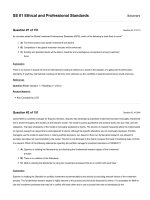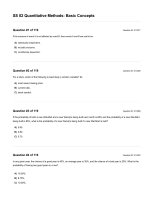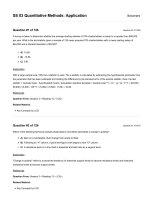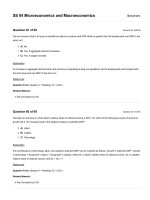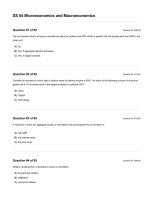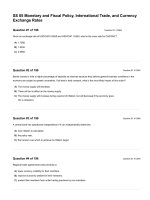CFA 2019 level 1 schwesernotes book 3
Bạn đang xem bản rút gọn của tài liệu. Xem và tải ngay bản đầy đủ của tài liệu tại đây (10.89 MB, 328 trang )
Contents
1. Learning Outcome Statements (LOS)
2. Study Session 6—Financial Reporting and Analysis (1)
1. Reading 21: Financial Statement Analysis: An Introduction
1. Exam Focus
2. Module 21.1: Financial Statement Roles
3. Module 21.2: Footnotes, Audit, and Analysis
4. Key Concepts
5. Answer Key for Module Quiz
2. Reading 22: Financial Reporting Standards
1. Exam Focus
2. Module 22.1: Standards Overview
3. Module 22.2: IFRS and U.S. GAAP
4. Module 22.3: Financial Reporting Framework
5. Key Concepts
6. Answer Key for Module Quizzes
3. Study Session 7—Financial Reporting and Analysis (2)
1. Reading 23: Understanding Income Statements
1. Exam Focus
2. Module 23.1: Income Statement Overview
3. Module 23.2: Percentage of Completion
4. Module 23.3: Installment Sales
5. Module 23.4: Expense Recognition
6. Module 23.5: EPS and Dilutive Securities
7. Module 23.6: Common-Size Income Statements
8. Key Concepts
9. Answer Key for Module Quizzes
2. Reading 24: Understanding Balance Sheets
1. Exam Focus
2. Module 24.1: Balance Sheet Introduction
3. Module 24.2: Assets and Liabilities
4. Module 24.3: Current Assets and Liabilities
5. Module 24.4: Noncurrent Assets and Liabilities
6. Module 24.5: Intangible Assets
7. Module 24.6: Marketable Securities
8. Module 24.7: Shareholders' Equity and Ratios
9. Key Concepts
10. Answer Key for Module Quizzes
3. Reading 25: Understanding Cash Flow Statements
1. Exam Focus
2. Module 25.1: Cash Flow Introduction
3. Module 25.2: The Direct and Indirect Methods
4. Module 25.3: Converting Direct to Indirect
5. Module 25.4: Free Cash Flow and Ratios
6. Key Concepts
7. Answer Key for Module Quizzes
4. Reading 26: Financial Analysis Techniques
1. Exam Focus
2. Module 26.1: Introduction to Financial Ratios
3. Module 26.2: Financial Ratios, Part 1
4. Module 26.3: Financial Ratios, Part 2
5. Module 26.4: DuPont Analysis
6. Module 26.5: More Financial Ratios
7. Key Concepts
8. Answer Key for Module Quizzes
4. Study Session 8—Financial Reporting and Analysis (3)
1. Reading 27: Inventories
1. Exam Focus
2. Module 27.1: Cost Flow Methods
3. Module 27.2: Inventory Systems
4. Module 27.3: Converting LIFO to FIFO
5. Module 27.4: Inventory Valuation
6. Module 27.5: Inventory Analysis
7. Key Concepts
8. Answer Key for Module Quizzes
2. Reading 28: Long-Lived Assets
1. Exam Focus
2. Module 28.1: Capitalization vs. Expensing
3. Module 28.2: Depreciation
4. Module 28.3: Impairment and Revaluation
5. Module 28.4: Leases and Fixed Asset Disclosures
6. Key Concepts
7. Answer Key for Module Quizzes
3. Reading 29: Income Taxes
1. Exam Focus
2. Module 29.1: Tax Terms
3. Module 29.2: Deferred Tax Liabilities and Assets
4. Module 29.3: Deferred Tax Examples
5. Module 29.4: Change in Tax Rates
6. Module 29.5: Permanent Differences
7. Key Concepts
8. Answer Key for Module Quizzes
4. Reading 30: Non-Current (Long-Term) Liabilities
1. Exam Focus
2. Module 30.1: Bond Issuance
3. Module 30.2: Discount and Premium Bonds
4. Module 30.3: Issuance Cost, Derecognition, and Disclosures
5. Module 30.4: Lessee Accounting
6. Module 30.5: Lessor Accounting
5.
6.
7.
8.
7. Module 30.6: Pension Plan Accounting
8. Key Concepts
9. Answer Key for Module Quizzes
Study Session 9— Financial Reporting and Analysis (4)
1. Reading 31: Financial Reporting Quality
1. Exam Focus
2. Module 31.1: Reporting Quality
3. Module 31.2: Accounting Choices and Estimates
4. Module 31.3: Warning Signs
5. Key Concepts
6. Answer Key for Module Quizzes
2. Reading 32: Financial Statement Analysis: Applications
1. Exam Focus
2. Module 32.1: Forecasting
3. Module 32.2: Credit and Equity Analysis
4. Key Concepts
5. Answer Key for Module Quiz
Topic Assessment: Financial Reporting and Analysis
Topic Assessment Answers: Financial Reporting and Analysis
Formulas
List of pages
1.
2.
3.
4.
5.
6.
7.
8.
9.
10.
11.
12.
13.
14.
15.
16.
17.
18.
19.
20.
21.
22.
23.
24.
25.
26.
27.
28.
29.
30.
31.
32.
33.
34.
35.
36.
37.
38.
39.
40.
41.
42.
vi
vii
viii
ix
x
xi
xii
1
2
3
4
5
6
7
8
9
10
11
12
13
14
15
16
17
18
19
20
21
23
24
25
27
28
29
30
31
32
33
34
35
36
37
43.
44.
45.
46.
47.
48.
49.
50.
51.
52.
53.
54.
55.
56.
57.
58.
59.
60.
61.
62.
63.
64.
65.
66.
67.
68.
69.
70.
71.
72.
73.
74.
75.
76.
77.
78.
79.
80.
81.
82.
83.
84.
85.
86.
87.
88.
38
39
40
41
42
43
44
45
46
47
48
49
50
51
52
53
54
55
56
57
58
59
60
61
62
63
65
66
67
68
69
70
71
72
73
74
75
76
77
78
79
80
81
82
83
84
89.
90.
91.
92.
93.
94.
95.
96.
97.
98.
99.
100.
101.
102.
103.
104.
105.
106.
107.
108.
109.
110.
111.
112.
113.
114.
115.
116.
117.
118.
119.
120.
121.
122.
123.
124.
125.
126.
127.
128.
129.
130.
131.
132.
133.
134.
85
86
87
89
90
91
92
93
94
95
97
98
99
100
101
102
103
104
105
106
107
108
109
110
111
112
113
114
115
116
117
118
119
121
122
123
124
125
126
127
128
129
130
131
132
133
135.
136.
137.
138.
139.
140.
141.
142.
143.
144.
145.
146.
147.
148.
149.
150.
151.
152.
153.
154.
155.
156.
157.
158.
159.
160.
161.
162.
163.
164.
165.
166.
167.
168.
169.
170.
171.
172.
173.
174.
175.
176.
177.
178.
179.
180.
134
135
136
137
138
139
140
141
142
143
144
145
146
147
148
149
150
151
152
153
154
155
156
157
158
159
160
161
162
163
164
165
167
168
169
170
171
172
173
175
176
177
178
179
180
181
181.
182.
183.
184.
185.
186.
187.
188.
189.
190.
191.
192.
193.
194.
195.
196.
197.
198.
199.
200.
201.
202.
203.
204.
205.
206.
207.
208.
209.
210.
211.
212.
213.
214.
215.
216.
217.
218.
219.
220.
221.
222.
223.
224.
225.
226.
182
183
184
185
186
187
188
189
190
191
192
193
194
195
196
197
198
199
200
201
202
203
205
206
207
208
209
210
211
212
213
214
215
216
217
218
219
220
221
222
223
224
225
226
227
228
227.
228.
229.
230.
231.
232.
233.
234.
235.
236.
237.
238.
239.
240.
241.
242.
243.
244.
245.
246.
247.
248.
249.
250.
251.
252.
253.
254.
255.
256.
257.
258.
259.
260.
261.
262.
263.
264.
265.
266.
267.
268.
269.
270.
271.
272.
229
230
231
232
233
234
235
236
237
238
239
240
241
242
243
244
245
246
247
248
249
251
252
253
254
255
256
257
258
259
260
261
262
263
264
265
266
267
268
269
270
271
272
273
274
275
273.
274.
275.
276.
277.
278.
279.
280.
281.
282.
283.
284.
285.
286.
287.
288.
289.
290.
291.
292.
293.
294.
295.
296.
297.
298.
299.
300.
301.
302.
303.
304.
305.
306.
307.
308.
309.
310.
311.
312.
313.
314.
315.
316.
317.
318.
276
277
278
279
280
281
282
283
284
285
286
287
288
289
290
291
292
293
294
295
296
297
298
299
301
302
303
304
305
306
307
308
309
310
311
312
313
314
315
316
317
318
319
321
322
323
319. 324
320. 325
LEARNING OUTCOME STATEMENTS (LOS)
STUDY SESSION 6
The topical coverage corresponds with the following CFA Institute assigned reading:
21. Financial Statement Analysis: An Introduction
The candidate should be able to:
a. describe the roles of financial reporting and financial statement analysis. (page 1)
b. describe the roles of the statement of financial position, statement of
comprehensive income, statement of changes in equity, and statement of cash
flows in evaluating a company’s performance and financial position. (page 2)
c. describe the importance of financial statement notes and supplementary
information—including disclosures of accounting policies, methods, and estimates
—and management’s commentary. (page 3)
d. describe the objective of audits of financial statements, the types of audit reports,
and the importance of effective internal controls. (page 4)
e. identify and describe information sources that analysts use in financial statement
analysis besides annual financial statements and supplementary information.
(page 5)
f. describe the steps in the financial statement analysis framework. (page 6)
The topical coverage corresponds with the following CFA Institute assigned reading:
22. Financial Reporting Standards
The candidate should be able to:
a. describe the objective of financial statements and the importance of financial
reporting standards in security analysis and valuation. (page 11)
b. describe roles and desirable attributes of financial reporting standard-setting bodies
and regulatory authorities in establishing and enforcing reporting standards, and
describe the role of the International Organization of Securities Commissions.
(page 12)
c. describe the status of global convergence of accounting standards and ongoing
barriers to developing one universally accepted set of financial reporting standards.
(page 13)
d. describe the International Accounting Standards Board’s conceptual framework,
including the objective and qualitative characteristics of financial statements,
required reporting elements, and constraints and assumptions in preparing
financial statements. (page 14)
e. describe general requirements for financial statements under International
Financial Reporting Standards (IFRS). (page 17)
f. compare key concepts of financial reporting standards under IFRS and US
generally accepted accounting principles (US GAAP) reporting systems. (page 18)
g. identify characteristics of a coherent financial reporting framework and the barriers
to creating such a framework. (page 18)
h. describe implications for financial analysis of differing financial reporting systems
and the importance of monitoring developments in financial reporting standards.
(page 19)
i. analyze company disclosures of significant accounting policies. (page 20)
STUDY SESSION 7
The topical coverage corresponds with the following CFA Institute assigned reading:
23. Understanding Income Statements
The candidate should be able to:
a. describe the components of the income statement and alternative presentation
formats of that statement. (page 28)
b. describe general principles of revenue recognition and accrual accounting, specific
revenue recognition applications (including accounting for long-term contracts,
installment sales, barter transactions, gross and net reporting of revenue), and
implications of revenue recognition principles for financial analysis. (page 30)
c. calculate revenue given information that might influence the choice of revenue
recognition method. (page 30)
d. describe key aspects of the converged accounting standards for revenue
recognition issued by the International Accounting Standards Board and Financial
Accounting Standards Board in May 2014. (page 35)
e. describe general principles of expense recognition, specific expense recognition
applications, and implications of expense recognition choices for financial
analysis. (page 38)
f. describe the financial reporting treatment and analysis of non-recurring items
(including discontinued operations, unusual or infrequent items) and changes in
accounting policies. (page 41)
g. distinguish between the operating and non-operating components of the income
statement. (page 43)
h. describe how earnings per share is calculated and calculate and interpret a
company’s earnings per share (both basic and diluted earnings per share) for both
simple and complex capital structures. (page 45)
i. distinguish between dilutive and antidilutive securities and describe the
implications of each for the earnings per share calculation. (page 45)
j. convert income statements to common-size income statements. (page 53)
k. evaluate a company’s financial performance using common-size income
statements and financial ratios based on the income statement. (page 54)
l. describe, calculate, and interpret comprehensive income. (page 54)
m. describe other comprehensive income and identify major types of items included
in it. (page 54)
The topical coverage corresponds with the following CFA Institute assigned reading:
24. Understanding Balance Sheets
The candidate should be able to:
a. describe the elements of the balance sheet: assets, liabilities, and equity. (page 65)
b. describe uses and limitations of the balance sheet in financial analysis. (page 66)
c. describe alternative formats of balance sheet presentation. (page 66)
d. distinguish between current and non-current assets and current and non-current
liabilities. (page 67)
e. describe different types of assets and liabilities and the measurement bases of each.
(page 68)
f. describe the components of shareholders’ equity. (page 76)
g. convert balance sheets to common-size balance sheets and interpret common-size
balance sheets. (page 78)
h. calculate and interpret liquidity and solvency ratios. (page 80)
The topical coverage corresponds with the following CFA Institute assigned reading:
25. Understanding Cash Flow Statements
The candidate should be able to:
a. compare cash flows from operating, investing, and financing activities and classify
cash flow items as relating to one of those three categories given a description of
the items. (page 90)
b. describe how non-cash investing and financing activities are reported. (page 91)
c. contrast cash flow statements prepared under International Financial Reporting
Standards (IFRS) and US generally accepted accounting principles (US GAAP).
(page 92)
d. distinguish between the direct and indirect methods of presenting cash from
operating activities and describe arguments in favor of each method. (page 92)
e. describe how the cash flow statement is linked to the income statement and the
balance sheet. (page 94)
f. describe the steps in the preparation of direct and indirect cash flow statements,
including how cash flows can be computed using income statement and balance
sheet data. (page 97)
g. convert cash flows from the indirect to direct method. (page 105)
h. analyze and interpret both reported and common-size cash flow statements.
(page 108)
i. calculate and interpret free cash flow to the firm, free cash flow to equity, and
performance and coverage cash flow ratios. (page 110)
The topical coverage corresponds with the following CFA Institute assigned reading:
26. Financial Analysis Techniques
The candidate should be able to:
a. describe tools and techniques used in financial analysis, including their uses and
limitations. (page 121)
b. classify, calculate, and interpret activity, liquidity, solvency, profitability, and
valuation ratios. (page 127)
c. describe relationships among ratios and evaluate a company using ratio analysis.
(page 137)
d. demonstrate the application of DuPont analysis of return on equity and calculate
and interpret effects of changes in its components. (page 140)
e. calculate and interpret ratios used in equity analysis and credit analysis. (page 144)
f. explain the requirements for segment reporting and calculate and interpret segment
ratios. (page 148)
g. describe how ratio analysis and other techniques can be used to model and forecast
earnings. (page 149)
STUDY SESSION 8
The topical coverage corresponds with the following CFA Institute assigned reading:
27. Inventories
The candidate should be able to:
a. distinguish between costs included in inventories and costs recognised as expenses
in the period in which they are incurred. (page 156)
b. describe different inventory valuation methods (cost formulas). (page 157)
c. calculate and compare cost of sales, gross profit, and ending inventory using
different inventory valuation methods and using perpetual and periodic inventory
systems. (page 158)
d. calculate and explain how inflation and deflation of inventory costs affect the
financial statements and ratios of companies that use different inventory valuation
methods. (page 163)
e. explain LIFO reserve and LIFO liquidation and their effects on financial
statements and ratios. (page 166)
f. convert a company’s reported financial statements from LIFO to FIFO for purposes
of comparison. (page 166)
g. describe the measurement of inventory at the lower of cost and net realisable value.
(page 171)
h. describe implications of valuing inventory at net realisable value for financial
statements and ratios. (page 173)
i. describe the financial statement presentation of and disclosures relating to
inventories. (page 173)
j. explain issues that analysts should consider when examining a company’s
inventory disclosures and other sources of information. (page 174)
k. calculate and compare ratios of companies, including companies that use different
inventory methods. (page 175)
l. analyze and compare the financial statements of companies, including companies
that use different inventory methods. (page 175)
The topical coverage corresponds with the following CFA Institute assigned reading:
28. Long-Lived Assets
The candidate should be able to:
a. distinguish between costs that are capitalised and costs that are expensed in the
period in which they are incurred. (page 189)
b. compare the financial reporting of the following types of intangible assets:
purchased, internally developed, acquired in a business combination. (page 191)
c. explain and evaluate how capitalising versus expensing costs in the period in
which they are incurred affects financial statements and ratios. (page 193)
d. describe the different depreciation methods for property, plant, and equipment and
calculate depreciation expense. (page 196)
e. describe how the choice of depreciation method and assumptions concerning
useful life and residual value affect depreciation expense, financial statements, and
ratios. (page 199)
f. describe the different amortisation methods for intangible assets with finite lives
and calculate amortisation expense. (page 200)
g. describe how the choice of amortisation method and assumptions concerning
useful life and residual value affect amortisation expense, financial statements, and
ratios. (page 201)
h. describe the revaluation model. (page 202)
i. explain the impairment of property, plant, and equipment and intangible assets.
(page 204)
j. explain the derecognition of property, plant, and equipment and intangible assets.
(page 206)
k. explain and evaluate how impairment, revaluation, and derecognition of property,
plant, and equipment and intangible assets affect financial statements and ratios.
(page 207)
l. describe the financial statement presentation of and disclosures relating to property,
plant, and equipment and intangible assets. (page 210)
m. analyze and interpret financial statement disclosures regarding property, plant, and
equipment and intangible assets. (page 211)
n. compare the financial reporting of investment property with that of property, plant,
and equipment. (page 212)
o. explain and evaluate how leasing rather than purchasing assets affects financial
statements and ratios. (page 213)
p. explain and evaluate how finance leases and operating leases affect financial
statements and ratios from the perspective of both the lessor and the lessee.
(page 213)
The topical coverage corresponds with the following CFA Institute assigned reading:
29. Income Taxes
The candidate should be able to:
a. describe the differences between accounting profit and taxable income and define
key terms, including deferred tax assets, deferred tax liabilities, valuation
allowance, taxes payable, and income tax expense. (page 225)
b. explain how deferred tax liabilities and assets are created and the factors that
determine how a company’s deferred tax liabilities and assets should be treated for
the purposes of financial analysis. (page 227)
c. calculate the tax base of a company’s assets and liabilities. (page 228)
d. calculate income tax expense, income taxes payable, deferred tax assets, and
deferred tax liabilities, and calculate and interpret the adjustment to the financial
statements related to a change in the income tax rate. (page 231)
e. evaluate the effect of tax rate changes on a company’s financial statements and
ratios. (page 234)
f. distinguish between temporary and permanent differences in pre-tax accounting
income and taxable income. (page 237)
g. describe the valuation allowance for deferred tax assets—when it is required and
what effect it has on financial statements. (page 238)
h. explain recognition and measurement of current and deferred tax items. (page 239)
i. analyze disclosures relating to deferred tax items and the effective tax rate
reconciliation and explain how information included in these disclosures affects a
company’s financial statements and financial ratios. (page 239)
j. identify the key provisions of and differences between income tax accounting under
International Financial Reporting Standards (IFRS) and US generally accepted
accounting principles (GAAP). (page 243)
The topical coverage corresponds with the following CFA Institute assigned reading:
30. Non-Current (Long-term) Liabilities
The candidate should be able to:
a. determine the initial recognition, initial measurement and subsequent measurement
of bonds. (page 252)
b. describe the effective interest method and calculate interest expense, amortisation
of bond discounts/premiums, and interest payments. (page 253)
c. explain the derecognition of debt. (page 259)
d. describe the role of debt covenants in protecting creditors. (page 260)
e. describe the financial statement presentation of and disclosures relating to debt.
(page 261)
f. explain motivations for leasing assets instead of purchasing them. (page 262)
g. distinguish between a finance lease and an operating lease from the perspectives of
the lessor and the lessee. (page 263)
h. determine the initial recognition, initial measurement, and subsequent
measurement of finance leases. (page 264)
i. compare the disclosures relating to finance and operating leases. (page 271)
j. compare the presentation and disclosure of defined contribution and defined benefit
pension plans. (page 271)
k. calculate and interpret leverage and coverage ratios. (page 273)
STUDY SESSION 9
The topical coverage corresponds with the following CFA Institute assigned reading:
31. Financial Reporting Quality
The candidate should be able to:
a. distinguish between financial reporting quality and quality of reported results
(including quality of earnings, cash flow, and balance sheet items). (page 281)
b. describe a spectrum for assessing financial reporting quality. (page 282)
c. distinguish between conservative and aggressive accounting. (page 283)
d. describe motivations that might cause management to issue financial reports that
are not high quality. (page 285)
e. describe conditions that are conducive to issuing low-quality, or even fraudulent,
financial reports. (page 285)
f. describe mechanisms that discipline financial reporting quality and the potential
limitations of those mechanisms. (page 286)
g. describe presentation choices, including non-GAAP measures, that could be used
to influence an analyst’s opinion. (page 287)
h. describe accounting methods (choices and estimates) that could be used to manage
earnings, cash flow, and balance sheet items. (page 288)
i. describe accounting warning signs and methods for detecting manipulation of
information in financial reports. (page 292)
The topical coverage corresponds with the following CFA Institute assigned reading:
32. Financial Statement Analysis: Applications
The candidate should be able to:
a. evaluate a company’s past financial performance and explain how a company’s
strategy is reflected in past financial performance. (page 301)
b. forecast a company’s future net income and cash flow. (page 302)
c. describe the role of financial statement analysis in assessing the credit quality of a
potential debt investment. (page 303)
d. describe the use of financial statement analysis in screening for potential equity
investments. (page 304)
e. explain appropriate analyst adjustments to a company’s financial statements to
facilitate comparison with another company. (page 305)
The following is a review of the Financial Reporting and Analysis (1) principles designed to address the
learning outcome statements set forth by CFA Institute. Cross-Reference to CFA Institute Assigned
Reading #21.
READING 21: FINANCIAL STATEMENT
ANALYSIS: AN INTRODUCTION
Study Session 6
EXAM FOCUS
This introduction may be useful to those who have no previous experience with
financial statements. While the income statement, balance sheet, and statement of cash
flows are covered in detail in subsequent readings, candidates should pay special
attention here to the other sources of information for financial analysis. The nature of
the audit report is important, as is the information that is contained in the footnotes to
financial statements, proxy statements, Management’s Discussion and Analysis, and the
supplementary schedules. A useful framework enumerating the steps in financial
statement analysis is presented.
MODULE 21.1: FINANCIAL STATEMENT
ROLES
LOS 21.a: Describe the roles of financial reporting and financial
statement analysis.
Video covering
this content is
available online.
CFA® Program Curriculum, Volume 3, page 6
Financial reporting refers to the way companies show their financial performance to
investors, creditors, and other interested parties by preparing and presenting financial
statements. According to the IASB Conceptual Framework for Financial Reporting
2010:
“The objective of general purpose financial reporting is to provide financial
information about the reporting entity that is useful to existing and potential
investors, lenders, and other creditors in making decisions about providing
resources to the entity. Those decisions involve buying, selling or holding equity
and debt instruments, and providing or settling loans and other forms of credit.”
The role of financial statement analysis is to use the information in a company’s
financial statements, along with other relevant information, to make economic
decisions. Examples of such decisions include whether to invest in the company’s
securities or recommend them to investors and whether to extend trade or bank credit to
the company. Analysts use financial statement data to evaluate a company’s past
performance and current financial position in order to form opinions about the
company’s ability to earn profits and generate cash flow in the future.
PROFESSOR’S NOTE
This topic review deals with financial analysis for external users. Management also performs
financial analysis in making everyday decisions. However, management may rely on internal
financial information that is likely maintained in a different format and unavailable to
external users.
LOS 21.b: Describe the roles of the statement of financial position, statement of
comprehensive income, statement of changes in equity, and statement of cash flows
in evaluating a company’s performance and financial position.
CFA® Program Curriculum, Volume 3, page 11
The balance sheet (also known as the statement of financial position or statement of
financial condition) reports the firm’s financial position at a point in time. The balance
sheet consists of three elements:
1. Assets are the resources controlled by the firm.
2. Liabilities are amounts owed to lenders and other creditors.
3. Owners’ equity is the residual interest in the net assets of an entity that remains
after deducting its liabilities.
Transactions are measured so that the fundamental accounting equation holds:
assets = liabilities + owners’ equity
The statement of comprehensive income reports all changes in equity except for
shareholder transactions (e.g., issuing stock, repurchasing stock, and paying dividends).
The income statement (also known as the statement of operations or the profit and loss
statement) reports on the financial performance of the firm over a period of time. The
elements of the income statement include revenues, expenses, and gains and losses.
Revenues are inflows from delivering or producing goods, rendering services, or
other activities that constitute the entity’s ongoing major or central operations.
Expenses are outflows from delivering or producing goods or services that
constitute the entity’s ongoing major or central operations.
Other income includes gains that may or may not arise in the ordinary course of
business.
The income statement can be combined with “other comprehensive income” and
presented as a single statement of comprehensive income. Alternatively, the income
statement and the statement of comprehensive income can be presented separately.
The statement of changes in equity reports the amounts and sources of changes in
equity investors’ investment in the firm over a period of time.
The statement of cash flows reports the company’s cash receipts and payments. These
cash flows are classified as follows:
Operating cash flows include the cash effects of transactions that involve the
normal business of the firm.
Investing cash flows are those resulting from the acquisition or sale of property,
plant, and equipment; of a subsidiary or segment; of securities; and of investments
in other firms.
Financing cash flows are those resulting from issuance or retirement of the firm’s
debt and equity securities and include dividends paid to stockholders.
MODULE 21.2: FOOTNOTES, AUDIT, AND
ANALYSIS
LOS 21.c: Describe the importance of financial statement notes and
supplementary information—including disclosures of accounting
policies, methods, and estimates—and management’s commentary.
Video covering
this content is
available online.
CFA® Program Curriculum, Volume 3, page 24
Financial statement notes (footnotes) include disclosures that provide further details
about the information summarized in the financial statements. Footnotes allow users to
improve their assessments of the amount, timing, and uncertainty of the estimates
reported in the financial statements. Footnotes:
Discuss the basis of presentation such as the fiscal period covered by the
statements and the inclusion of consolidated entities.
Provide information about accounting methods, assumptions, and estimates used
by management.
Provide additional information on items such as business acquisitions or
disposals, legal actions, employee benefit plans, contingencies and commitments,
significant customers, sales to related parties, and segments of the firm.
Management’s commentary [also known as management’s report, operating and
financial review, and management’s discussion and analysis (MD&A)] is one of the
most useful sections of the annual report. In this section, management discusses a
variety of issues. IFRS guidance recommends that management commentary address the
nature of the business, management’s objectives, the company’s past performance, the
performance measures used, and the company’s key relationships, resources, and risks.
Analysts must be aware that some parts of management’s commentary may be
unaudited.
For publicly held firms in the United States, the SEC requires that MD&A discuss
trends and identify significant events and uncertainties that affect the firm’s liquidity,
capital resources, and results of operations. MD&A must also discuss:
Effects of inflation and changing prices if material.
Impact of off-balance-sheet obligations and contractual obligations such as
purchase commitments.
Accounting policies that require significant judgment by management.
Forward-looking expenditures and divestitures.
LOS 21.d: Describe the objective of audits of financial statements, the types of
audit reports, and the importance of effective internal controls.
CFA® Program Curriculum, Volume 3, page 27
An audit is an independent review of an entity’s financial statements. Public
accountants conduct audits and examine the financial reports and supporting records.
The objective of an audit is to enable the auditor to provide an opinion on the fairness
and reliability of the financial statements.
The independent certified public accounting firm employed by the Board of Directors is
responsible for seeing that the financial statements conform to the applicable accounting
standards. The auditor examines the company’s accounting and internal control systems,
confirms assets and liabilities, and generally tries to determine that there are no material
errors in the financial statements. The auditor’s report is an important source of
information.
The standard auditor’s opinion contains three parts and states that:
1. Whereas the financial statements are prepared by management and are its
responsibility, the auditor has performed an independent review.
2. Generally accepted auditing standards were followed, thus providing reasonable
assurance that the financial statements contain no material errors.
3. The auditor is satisfied that the statements were prepared in accordance with
accepted accounting principles and that the principles chosen and estimates made
are reasonable. The auditor’s report must also contain additional explanation when
accounting methods have not been used consistently between periods.
An unqualified opinion (also known as a clean opinion) indicates that the auditor
believes the statements are free from material omissions and errors. If the statements
make any exceptions to the accounting principles, the auditor may issue a qualified
opinion and explain these exceptions in the audit report. The auditor can issue an
adverse opinion if the statements are not presented fairly or are materially
nonconforming with accounting standards. If the auditor is unable to express an opinion
(e.g., in the case of a scope limitation), a disclaimer of opinion is issued.
The auditor’s opinion will also contain an explanatory paragraph when a material loss is
probable but the amount cannot be reasonably estimated. These “uncertainties” may
relate to the going concern assumption (the assumption that the firm will continue to
operate for the foreseeable future), the valuation or realization of asset values, or to
litigation. This type of disclosure may be a signal of serious problems and may call for
close examination by the analyst.
Internal controls are the processes by which the company ensures that it presents
accurate financial statements. Internal controls are the responsibility of management.
For publicly traded firms in the United States, the auditor must express an opinion on
the firm’s internal controls. The auditor can provide this opinion separately or as the
fourth element of the standard opinion.
LOS 21.e: Identify and describe information sources that analysts use in financial
statement analysis besides annual financial statements and supplementary
information.
CFA® Program Curriculum, Volume 3, page 29
Besides the annual financial statements, an analyst should examine a company’s
quarterly or semiannual reports. These interim reports typically update the major
financial statements and footnotes but are not necessarily audited.
Securities and Exchange Commission (SEC) filings are available from EDGAR
(Electronic Data Gathering, Analysis, and Retrieval System, www.sec.gov). These
include Form 8-K, which a company must file to report events such as acquisitions and
disposals of major assets or changes in its management or corporate governance.
Companies’ annual and quarterly financial statements are also filed with the SEC (Form
10-K and Form 10-Q, respectively).
Proxy statements are issued to shareholders when there are matters that require a
shareholder vote. These statements, which are also filed with the SEC and available
from EDGAR, are a good source of information about the election of (and qualifications
of) board members, compensation, management qualifications, and the issuance of
stock options.
Corporate reports and press releases are written by management and are often viewed
as public relations or sales materials. Not all of the material is independently reviewed
by outside auditors. Such information can often be found on the company’s website.
Firms often provide earnings guidance before the financial statements are released.
Once an earnings announcement is made, a conference call may be held whereby senior
management is available to answer questions.
An analyst should also review pertinent information on economic conditions and the
company’s industry and compare the company to its competitors. The necessary
information can be acquired from trade journals, statistical reporting services, and
government agencies.
LOS 21.f: Describe the steps in the financial statement analysis framework.
CFA® Program Curriculum, Volume 3, page 30
The financial statement analysis framework1 consists of six steps:
Step 1:
State the objective and context. Determine what questions the analysis
seeks to answer, the form in which this information needs to be presented,
and what resources and how much time are available to perform the
analysis.
Step 2:
Gather data. Acquire the company’s financial statements and other
relevant data on its industry and the economy. Ask questions of the
company’s management, suppliers, and customers, and visit company sites.
Step 3:
Process the data. Make any appropriate adjustments to the financial
statements. Calculate ratios. Prepare exhibits such as graphs and commonsize balance sheets.
